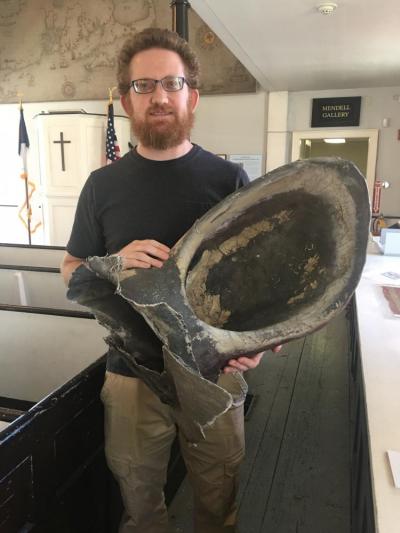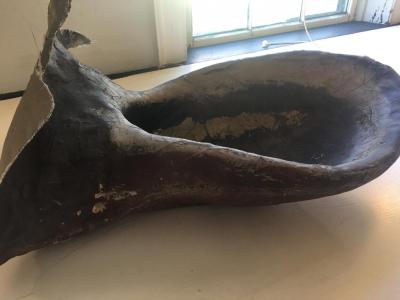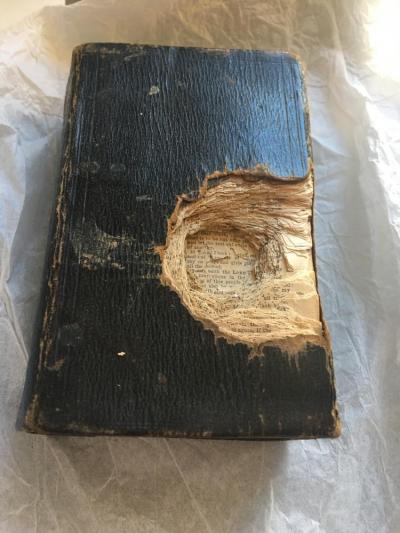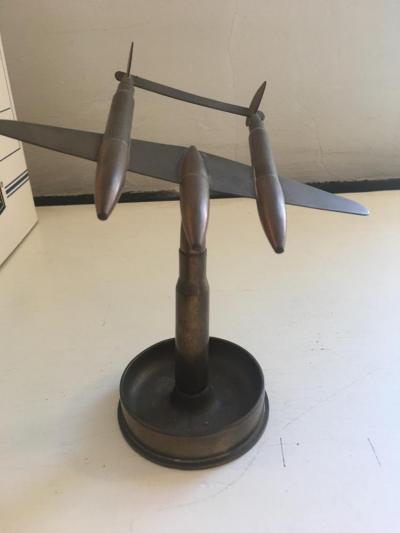Offbeat on exhibit at Mattapoisett Museum
MATTAPOISETT — Faith saved the life of Mattapoisett resident Albert Gorham, who served in the Navy during the Civil War.
Or more specifically, his faithful Bible did.
Gorham had his Bible in his pocket when he was shot in 1856 during a Civil War battle. But he survived, because the brunt of the bullet’s impact was taken by his Bible.
The heavily damaged holy book can be viewed by visitors to Mattapoisett’s Weird & Wonderful, an exhibit that opens at 5:30 p.m. Thursday, July 7 at the museum, 5 Church St.
The exhibit features an offbeat collection of items that do not fit a specific themed show but reflect various pieces of Mattapoisett history, said museum director Jeffrey Miller.
“Hopefully, we will have something here for everyone,’’ he said
For example, few exhibits allow visitors to feast their eyes on a cow’s ear.
This cow ear is larger than life, stretching to about three feet in length. Then again, it was never attached to a living, breathing bovine.
Instead, the cow ear was part of a giant billboard that advertised Mattapoisett’s Gulf Hill Dairy ice cream business in the 1950s and 1960s. The sign was located near the current location of Oxford Creamery on Route 6.
The billboard, located across the street from the ice cream stand, featured two fiberglass cow heads, steering people to the popular summer cooling spot. “Apparently it was quite a landmark,’’ Miller said,
When the billboard was eventually dismantled, the cow ear was apparently left behind in nearby bushes, Miller said. The ear was found by someone and eventually located in someone’s garage until the donor gave the ear to the museum.
These quirky items did not fit into any specific exhibit, Miller said, but are worth seeing. “We wanted to do an exhibit that was kind of quirky, kind of fun and not too-serious,’’ he said, but instead has a “light-hearted’’ feel.
“They might even have a laugh or two,’’ he said.
The display, for example, also includes a portrait of Abraham Lincoln.
“Or is it?’’ Miller asked.
At first glance the portrait differs little from countless other such depictions. But on closer inspection, Honest Abe’s head looks oversized and the legs appear short for a man known for his height.
The print’s origins are unknown but the discrepancies piqued Miller’s curiosity as to the origins and accuracy of the work. “I thought it was funny,’’ he said.
Then there is the ashtray created by using bullet casings to resemble war planes.
This is an example of “trench art,’’ which was made by soldiers in the field. This one, Miller suspects, was made during the World War II era from kits that were sold during that time then to help military members create works they could send home. This piece of trench art depicts a P-38 World War II.
The exhibit is on display during museum hours, noon to 4 p.m. Thursday through Sunday.
Miller hopes visitors will bring their curiosity and their senses of humor. “I think they’ll learn a little bit about a lot of things,’’ he said. “It’s something visitors can have fun with.’’














